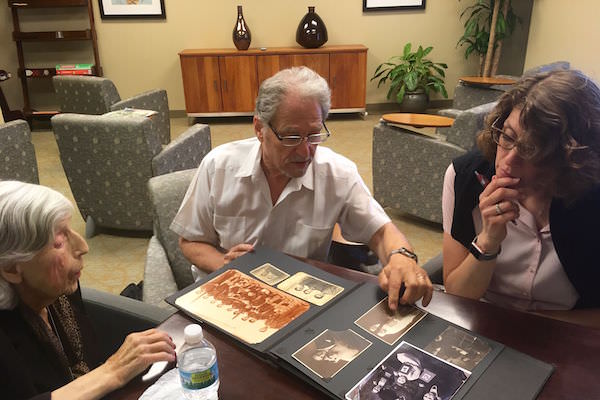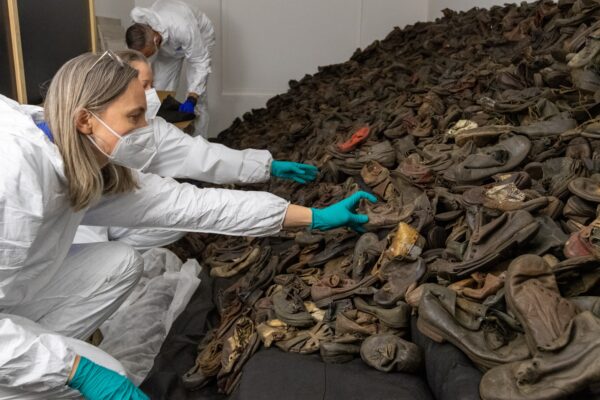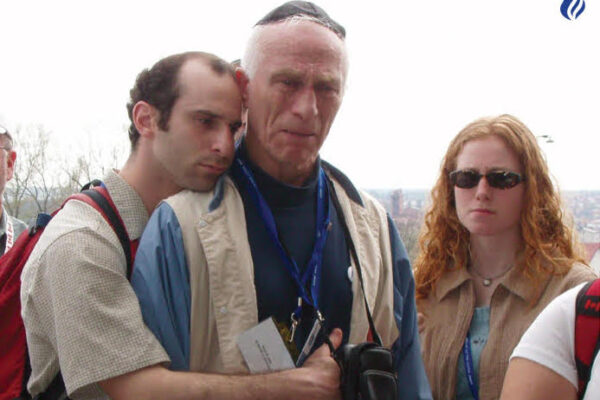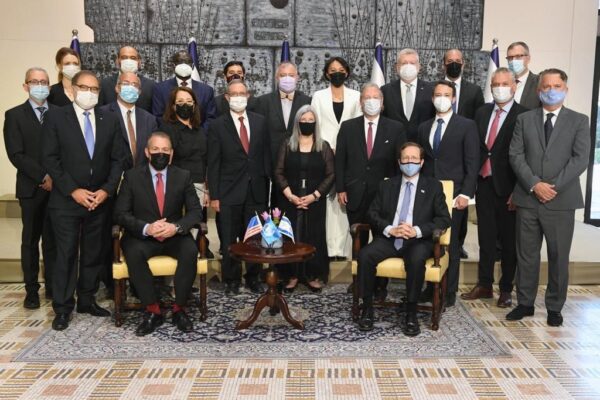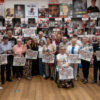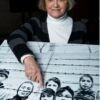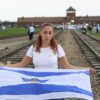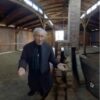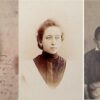
The Forward – For the past 26 years, Susan Goldstein Snyder, a curator at the United States Holocaust Memorial Museum, has traveled across the U.S. and Europe meeting with survivors (and, increasingly, their children and grandchildren), listening to their stories, and persuading them to donate their artifacts to the museum.
Over the course of her career, she has brought in 1,000 collections, including photos, documents, clothing, pieces of Judaica such as mezuzahs and menorahs, and even home movies from before the war.
Many of the people Snyder meets are reluctant to give away their heirlooms to a stranger. “My goal is to meet with people and get to know them,” she said one recent morning in Chicago as she prepared for a meeting with a survivor and her family. “They’re not ready to hand over material on the first visit. But I want to know what collections are out there.”
The museum has a broad definition of what constitutes a Holocaust artifact: it can be anything that dates from between the rise of Nazism in Germany in 1933 to the closing of the Displaced Persons camps in 1949, and it can belong to anyone who was persecuted during the Holocaust, not just Jews.
Snyder had met Brenda and David Huss and their son Fred during the Chicago stop on the museum’s 20th anniversary tour in 2013. The Husses had given her the basic outline of their story at that meeting: Brenda and David had both grown up in Horodenka, a town in Galicia — then part of Poland, now part of Ukraine. David had spent most of World War II in Stavropol, Russia. Brenda had stayed in Horodenka and survived by hiding in and around the town, including two years in a nearby cave. They’d married sometime after the liberation of eastern Poland in 1944 and, after the war, began to make their way west. Fred had been born in a DP camp in Darmstadt, Germany, in 1948, and they arrived in America the following year.
Snyder had all this information neatly written on pages torn from a small notebook that she kept clipped to a more general fact sheet about the Husses. On every collecting trip, she tries to visit three or four families, and she had called Fred Huss when she began planning this visit to Chicago. Since their first meeting four years ago, Fred told her, some things had changed. David had died. Brenda was now 92 and had had a stroke, which hampered her ability to speak. Time was running short. “This is our opportunity,” Snyder said. “We can’t let it go to waste.”
Brenda Huss lives in a senior community in the suburb of Deerfield. Fred drove up from his home in West Rogers Park with his teenage daughter Tallulah, bearing several bags of scrapbooks and two artifacts from his infancy: a pillowcase from his baby carriage and a tin jug that had once held goat milk. Brenda was not in her apartment; Fred had to fetch her from a lecture. She moved slowly, leaning on a walker. She was tiny, almost child-sized, and neatly dressed in a brown pantsuit with a leopard-print scarf knotted around her neck. Her face was made up and her hair looked like it had been recently styled. Her voice was slightly slurred when she spoke, but her eyes were alert. Her father had founded a Jewish school in Horodenka where she’d worked as a teacher, and she could read and speak seven languages. She did not look like someone who had lived two years in a cave.
“Sometimes I meet people, and I think, what the heck, how are they so bloody strong?” Snyder said before she went to meet the Husses. “What’s amazing to me is that we assume that the men are strong, but the women are really tough. The women really held it together.”
Snyder began the interview by asking Brenda simple questions that could be answered in a few words. Yes, she had been born in Horodenka. Her birth name was Chaya Brocha Fettner. She had been one of seven children, raised by their father and grandmother; their mother had died in childbirth. One brother died young, before the war, and another joined the Russian army. Before they went into hiding, Brenda worked in the local Gestapo office.
“What did you do there?” Snyder asked.
“I helped them keep things intact,” Brenda answered.
“You were cleaning up after torture,” Fred added.
“Yes,” Brenda agreed. “After they would torture people, I would work for them and clean up blood.”
Throughout the interview, Fred sat by his mother’s side, offering prompts and adding explanations. He’s an enthusiastic amateur historian and has been researching his parents’ story for the past 20 years. “I was keen to fill in as many details as possible,” he told Snyder. He has 48 hours of audio recordings of David and Brenda; at one point, Brenda helped identify a Gestapo officer by remembering a man who had a limp. He now considers himself a living, breathing repository of his parents’ history. Brenda herself has told the story so many times that she’s compressed it to the barest essentials, almost like poetry.
Brenda and four of her siblings went into hiding in 1941. Their father and grandmother had been killed in a mass shooting after they dug their own graves; only one person survived. (The survivor wrote a poem in Yiddish about it, which Brenda later translated.) At first, Fred explained, the siblings hid in a basement in town, then on a farm. They learned about the cave from a baker’s assistant; they found it by jumping up and down. Eventually nine or ten people lived there. They hunted and foraged for food in the woods and cooked it on a stove a metalworker had made for them back in town. Brenda’s sister Rivka and her younger brother Fievel both died from hunger within two weeks of each other; the others buried them at the mouth of the cave.
“What was it like?” Snyder asked. “Was it cold? Hot?”
“It was not cold, not hot,” Brenda replied. “The air was not disturbing us. We were comfortable. We were satisfied with each one’s boulder.”
“Did it get squirrelly?” Snyder asked. “Was there conflict?”
“No.”
“Everyone maintained decorum?”
“There was nothing to talk about.”
“What about how you would go out at night and sing?” Fred prompted.
“We would sing songs, not war songs, to keep us going. We did not talk about how maybe things would get better. Everything was sacred. Everything. Every piece of bread.”
Fred began to speak more when it came time to describe his parents’ movements after the war. They met again in Horodenka, where they were living with other survivors in abandoned houses. By the time they arrived in Liegnitz (now Legnica), about 600 miles away, they were married. David worked as a barber, and they took portraits of Russian soldiers with a Leica camera they’d bought from soldiers who needed money for vodka. They had no papers or identification. “We still lived in fear,” Brenda said. “We had no piece of earth. We could not collect rations.”
At this point in the story, Fred brought out the family photo album. The first few pages were family photos from before the war. Brenda had found some of them in the street after she returned to Horodenka. Then there was a gap of several years, and the visual chronicle picked up again in 1945 at a New Year’s Eve party in Liegnitz. The photos show a handsome young couple — Brenda was still just 20 years old—nattily dressed and very much in love.
“Then there were the pogroms,” Fred said.
“July of 1946,” Snyder added promptly. That summer, blood libel rumors (possibly planted by the Soviets) led to pogroms across Poland; in July, the Polish defense minister signed an agreement with Bricha, an underground agency that helped Holocaust survivors emigrate to Palestine, that allowed Jews to leave the country without visas or exit permits. Most of them did, including the Husses.
They made it as far as Germany, but the plan to immigrate to Palestine fell through because Brenda was pregnant with Fred. Instead, they remained in Germany, living mostly in Dieberg, until the fall of 1949 when they finally were able to leave for Newark, N.J., thanks to the sponsor of a cousin Ethel. While they were trying to make contact with relatives in America, Brenda mistakenly wrote to a man in Newark who had the same name as one of her cousins, Meyer Miller. He wrote back, and a lengthy correspondence in Yiddish ensued. By the time Brenda and David arrived in Newark, the Millers greeted them as though they were part of their own family. It was something Brenda, who had lost most of her biological family through death or separation, never forgot.
Fred had collected all the letters in a binder and had them translated by a historian. “I can’t believe you saved them!” Snyder exclaimed, flipping through the pages covered with neat Hebrew script. “These are unbelievable.” She didn’t bother to hide her excitement. One of the museum’s current initiatives is a study of the American response to the Holocaust, both the positive, like the Millers, and negative, like the immigration quotas that kept Jews out. The more material like those letters the museum collects, she explained, the more complete story scholars will be able to tell.
“She kept everything,” Fred said. He pulled out another, thicker binder of all their paperwork, which he’d hired a graphic conservator to put together. (“If I told you how much it cost,” he told Snyder, looking over at Brenda, “she’ll throw up.”)
Snyder examined the documents and other artifacts Fred had brought along: two Hebrew-Yiddish dictionaries from the DP camps, an old prayer book Brenda had acquired as a young teacher in Horodenka, the pillowcase, and the milk jug.
Finally she got to the point. “You know I’m going to ask you if you’ll donate this. I know you’re not ready to part with the documents.”
“I’ll have to sit down and think about it,” Brenda said.
“Maybe duplicates of the photos and the Miller letters?” Snyder suggested.
“Would you like to give them the Miller letters?” Fred asked Brenda.
“I cannot,” Brenda said. “Miller adopted me. He didn’t even know us.”
“We can tell the story of how the Millers adopted you,” Snyder said.
“I wouldn’t mind letting them have the Miller letters,” Fred told Brenda. “I have scans and translations. Do you mind if we give them the letters and help the story get told?”
Brenda remained unconvinced. “When can we meet again?”
Snyder would be leaving Chicago the day after next. Fred promised to be in touch. They parted on friendly terms. Brenda and Snyder discussed another woman who lived in Brenda’s community, also a survivor with whom Snyder had been in contact. The woman was depressed and isolated, and Brenda had made an effort to befriend her. “It is because I am not an American,” she explained.
“Yes,” Snyder agreed. “So many of you had to go ahead with your lives. You never had a chance to grieve.”
Whatever Brenda would decide, Snyder was not discouraged. Long experience has taught her that people won’t part with their heirlooms until they’re ready; one of her colleagues once waited seven years for a diary. But she knew the Husses now and their story, and they knew her.
“Can I give you a kiss?” she asked Brenda as they said goodbye. Brenda nodded. “You’re really remarkable,” Snyder told her. “Thank you for sharing with us.”
The next day, Snyder heard from Fred again. Brenda had agreed to donate some of the photographs and the Miller letters.
Originally Published HERE By Aimee Levitt
